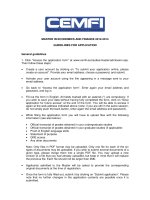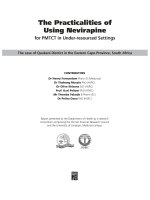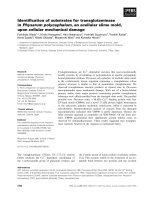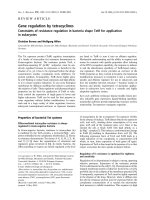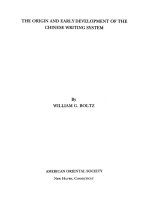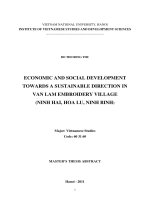nvestigating the influences of tidal inundation and surface elevation on the establishment and early development of mangroves for application in understanding mangrove rehabilitation techniques 1 6
Bạn đang xem bản rút gọn của tài liệu. Xem và tải ngay bản đầy đủ của tài liệu tại đây (248.7 KB, 10 trang )
66
Chapter 5 – General Discussion
Mangrove rehabilitation efforts are strongly supported by many governments,
intergovernmental agencies and NGOs, but have met with mixed success. Since
ecosystems are inherently dynamic, the ability to predict and manage rehabilitation
trajectories are very challenging (Anand & Desrochers, 2004; Ruiz-Jaen & Aide,
2005). Palmer et al. (1997) and Hildebrand et al. (2005) cautioned that these complex
landscapes should be partitioned into “understandable subsets” in order to develop
theory and generalities that can further the understanding of “restoration ecology” (the
equivalent of “rehabilitation ecology”). Furthermore, rehabilitation goals must be
realistic and include multiple endpoints that can be subjected to scientific testing
(Hildebrand et al., 2005).
This thesis aimed to contribute to the understanding of hydrologic management in the
success of mangrove rehabilitation projects. It aimed to investigate how the knowledge
of (i) surface elevation in controlling mangrove establishment and development and
(ii) species-specific inundation thresholds contributes to mangrove rehabilitation
success. This was achieved through a field study and a controlled mesocosm
experiment.
5.1 Principal findings
5.1.1. Effects of surface elevation on mangrove establishment
The first objective investigated how hydrologic restoration contributed to the
successful establishment of mangrove vegetation in a rehabilitated site. Overall,
establishment rates were low and were restricted to higher elevation ranges around the
perimeter of aquaculture ponds. Also, the surface elevations at which seedling/sapling
67
establishment occurred were similar across both rehabilitation site and natural
reference forests. This highlights that surface elevation is a potentially a key influence
on the establishment and colonisation of mangroves as it controls inundation
hydroperiod (i.e. inundation frequency and duration). At inappropriate surface
elevations, establishment of propagules becomes impeded through (i) lack of
inundation-free periods and (ii) a sufficiently long inundation-free duration that
favours both propagule stranding and root development for anchoring into substrate.
Assuming successful establishment, surface elevations continue to influence
subsequent development into seedlings and saplings. Effectively, the relationship
between survival and growth of mangrove seedlings is that prolonged inundation
hydroperiod (i.e. low elevations) decreases seedling survivorship and growth (Ellison
& Farnsworth, 1997; Kitaya et al., 2002; Chen et al., 2005; Chen et al., 2013).
Contributing reasons are that prolonged inundation impedes aerobic metabolism
(McKee, 1996) and also causes a build-up of phytotoxins in anoxic soil that in turn
affects plant growth through inhibition of photosynthetic gas exchange and oxygen
available to roots (McKee, 1993; Youssef & Saenger, 1998). In mature mangrove
communities, inundation hydroperiod has also been shown to explain for distribution
patterns, first by Watson (1928) and more recently by Crase et al. (2013).
5.1.2. Effects of prolonged inundation on seedling survival and development
The second objective quantified the inundation thresholds impacting the survival and
growth for two selected mangrove species – Rhizophora mucronata and Avicennia
alba.
Analyses revealed species-specific responses to inundation duration. Avicennia
seedlings exhibited an inundation threshold of approximately 5 hours, after which
68
prolonged inundation decreased survivorship and inhibited seedling height. No such
threshold was exhibited in Rhizophora seedlings. This species-specific response may
be explained by the superior ability of Rhizophora to maintain positive net
photosynthesis through sustaining functional photochemical and biochemical systems
when (Pezeshki et al., 1987). This is accounted for by inter-species differences to in
plant physiology (root aerenchyma to store oxygen), propagule reserves (Smith &
Snedaker, 2000) and reproductive strategy (Tomlinson, 1986; Elmqvist & Cox, 1996;
Tomlinson & Cox, 2000).
5.2 A synthesis: Reconciling a field study and a mesocosm experiment
After reproductive propagules have escaped losses from pre-dispersal herbivory and
dispersal, they have to overcome multiple constraints to establishment and early
development of mangrove seedlings. These constraints either act in isolation or
synergistically, encompassing variables such as temperature, carbon dioxide, salinity,
light, nutrients, inundation and biotic entities (sensu Krauss et al., 2008). The field
study presents field data that show establishment is constrained by surface elevations
as mangrove establishment occurs within specific elevation ranges in both aquaculture
ponds and natural reference forests. The field data was further expanded on by through
executing a controlled mesocosm experiment, designed to provide complementary
knowledge by determining species-specific thresholds to manipulated inundation
durations. Additionally, the mesocosm experiment functioned to explicitly control for
confounding factors in the field study which may exert a combined influence on
seedlings. For instance, inundation tolerance thresholds were influenced by a salinity
gradient in Kandelia obovata trees. K. obovata exhibited longer inundation duration
tolerances as salinity decreased and this determined the spatial distribution of mature
trees (Yang et al., 2013). The experiment investigated only the relationship between
69
manipulated inundation durations and its effect on seedling survival and growth. Thus
observed responses can be directly linked to the influence of prolonged inundation,
conditions similar to lower surface elevations in mangroves. Yet, the mesocosm
experiment arguably over simplifies realistic conditions in the field. As mentioned
above, the spatial distribution of mangrove establishment can be influenced by many
factors. Hence, the need for a field validation to show that effect of surface elevation
on establishment can still be observed even in face of a combination of such
interacting factors. The field study further expands knowledge beyond two species as
the data collected corresponds to the spatial distribution of mangroves across 14
species and life stages (seedling, sapling and trees).
Taken together, this thesis provides an insight on the importance of appropriate surface
elevations in establishment and colonisation for the reforestation of rehabilitated sites.
Mangroves establish at specific surface elevation ranges and arguably, they can only
survive and develop at optimal inundation durations upon successful establishment. It
highlights the need for rehabilitation planners and practitioners to alter surface
elevations in degraded sites to a degree that favours natural colonisation and
establishment.
5.3 Implications for mangrove rehabilitation
Managed appropriately, mangrove rehabilitation through natural succession or human-
aided secondary succession can produce self-sustaining ecosystems resilient to normal
periodic stresses (Simenstad et al., 2006; Elliott et al., 2007; Borja et al., 2010), It is
encouraging to note that there exist rehabilitation projects that have employed this
EMR approach in achieving successful rehabilitation (reforestation). Examples of
70
projects combining different hydrological and EMR approaches have been
comprehensively summarised and discussed in an EMR manual published by Lewis
and Brown (2014), Sections 8.7 and 10. Table 5.1 presents a comparison of the
techniques employed in these projects in achieving successful mangrove reforestation.
Each project employed a unique combination of EMR techniques, dependent on site-
specific requirements. Although two projects did involving replanting of mangroves,
rehabilitation techniques employed in remaining projects proved sufficient in inducing
natural colonisation of mangrove vegetation. In general, the techniques employed to
rehabilitate aquaculture ponds in Kuri Caddi (i.e. strategic breaching, regrading and
broadcasting of propagules) was similar to these projects. However, the rehabilitation
goal of reforestation was not achieved due to inappropriate surface elevations in
aquaculture ponds.
71
Table 5.1: A summary of the EMR rehabilitation techniques employed across eight mangrove
rehabilitation projects in achieving successful reforestation (Lewis & Brown, 2014).
Name of
site
Country
Area
(Ha)
Techniques
Hydrological
rehabilitation
Tidal creek
Excavation
Strategic
Breaching
Regrading
Planting
West Lake,
Florida
U.S.A.
500
√
√
Sunken
Island,
Florida
U.S.A.
1.7
√
√ (Marsh
grass planted
to stabilise
sediments)
40 Dredged
Material
Islands, East
and West
Florida
Coasts
U.S.A.
108.5*
√ (Fill was
required)
Tiwoho,
North
Sulawesi
Indonesia
20
√ (Infilling
of
aquaculture
channels)
√
√
√ (Some
mangrove
replanting
by the
government
and students
Tanakeke
Island, South
Sulawesi
Indonesia
400
√
√
√
√ Soil
mounds
to raise
elevation
NE Langkat
Wildlife
Sanctuary,
North
Sumatera
Indonesia
12
√
√ (6 species
were planted
in half of
entire area)
Hillsborough
Bay, Florida
U.S.A.
5
√
√ (Marsh
grass planted
to stabilise
sediments)
Pelican
Island,
Florida
U.S.A.
1
√ (Marsh
grass planted
to stabilise
sediments;
Rhizophora
mangle
planted)
*Additional data was retrieved from Lewis & Lewis, 1978.
An immediate implication of this study is that mangrove rehabilitation practitioners
should more strongly consider surface elevations as a critical component of mangrove
72
rehabilitation approaches. This thesis has provided evidence that surface elevation and
its control on inundation hydroperiod has influences on the establishment,
colonisation, survival and development of mangroves (Chapters 3 and 4), and hence
rehabilitation (reforestation) success. The thesis provides support that strengthens the
main guiding principle of EMR whereby rehabilitation should work within the
physical boundary conditions that control mangrove establishment and survival, such
as tidal hydrology, flushing and wave action (Lewis, 2005; Lewis & Gilmore, 2007;
Chen et al., 2012; Winterwerp et al., 2013, Lewis & Brown, 2014).
Secondly, this study reiterates the importance for periodic monitoring and management
of rehabilitation sites in achieving rehabilitation success. While there is initial success
in seedling establishment and colonisation, continual monitoring is necessary to track
future colonisation and forest regeneration trajectories for a complete assessment of
the progress and success of the rehabilitation program. Rehabilitation and management
should be constantly re-evaluated based on actual ecosystem response to management
(Holling, 1978; Walters, 1986, Lewis & Brown, 2014).
Lastly, there is an urgent need to get knowledge and data gleaned from such
rehabilitation out to both rehabilitation scientists and practitioners. Only a small subset
of rehabilitation projects implemented have been planned or analysed by ecologists
and other scientists (Kentula, 2000). There is a general lack of data and consistent
documentation describing rehabilitation efforts, making it difficult to review and
determine the reasons for success or failure of rehabilitation projects. This impedes
future efforts in improving rehabilitation design in achieving higher rates of
rehabilitation success.
73
5.4 Recommendations
5.4.1. Identifying disturbance-free periods that favour establishment and colonisation
Chapter 3 provided evidence that inappropriate surface elevations were impeding
successful mangrove establishment and colonisation. Yet, the nature of field studies
encompasses the inability to control for other physical (e.g. similar substrate
composition), biological (e.g. propagule fruiting seasons) and ecological factors (e.g.
propagule predation by crabs; Smith et al., 2009) that could have influenced propagule
establishment, colonisation and development processes. This was addressed partially
through the mesocosm experiment that kept all other such variables constant and
investigated solely, the relationship between seedling survival and development and
inundation durations. An extension would be to investigate the relationship between
inundation hydroperiod (i.e. inundation frequency and duration) and species-specific
propagule establishment, across an elevation gradient. This was not viable in this study
given logistical and funding restrictions. Yet, the knowledge gleaned would be useful
in identifying the minimum inundation hydroperiod that would provide disturbance-
free periods to allow sufficient time for root development in stranded propagules to
withstand disturbances such as removal by tidal flooding and wave energy. Balke et al.
(2011) coined the term “Windows of Opportunity” to describe these disturbance-free
periods. It follows that such windows would vary across an elevation gradient,
environmental conditions and between ecosystems. In the context of revegetation at
degraded sites, a combination of such knowledge could guide rehabilitation
practitioners in identifying the appropriate surface elevations and time in the tidal
regime for such revegetation actions (e.g. broadcasting of mangrove propagules).
74
5.4.2 Implement mid-course corrections
The vegetation survey for established vegetation in rehabilitated ponds was conducted
in June 2014, 6 months after rehabilitation was completed. Despite recognition in June
2014 that surface elevations in aquaculture ponds were too low, funding restrictions
imposed by collaborative partners hindered the planned implementation of mid-course
corrective actions. An ideal extension to improve on this study would be to test if
increase in surface elevation and presence of more aboveground structures could aid
propagule establishment. More dike walls could be graded down to produce substrate
to increase the surface elevations in ponds to that similar in reference forests. Then,
more aboveground structures such brush piles could be created to increase “surface
roughness” before repeating the broadcast of propagules. Lastly, a second vegetation
survey could be conducted to monitor if any new vegetation had established on site.
5.4.3 Long-term monitoring of recovery trajectory
To predict if the rehabilitation goal of reforesting aquaculture ponds can be achieved in
a few years, prediction maps were generated. Surface elevations of established trees in
natural reference forests were used to identify comparable surface elevations in
aquaculture ponds. Yet, it is recognised that the predicted distributions may be overly
conservative as it was founded on a subset, instead of the full surface elevation
gradients that natural mangrove forests can occupy. Effectively, the prediction maps
created in this study fail to account for the upper elevation range (on the landward
side) that mangroves once occupied before conversion into aquaculture ponds,
agricultural fields and other urban developments. Also, while the Rhizophora seedlings
had survived the experiment duration of two months, they might eventually die when
energy stores within the propagule finish. Instead of attempts at predicting the
75
rehabilitation outcome based on reference forests and through a mesocosm experiment,
the focus should be shifted into investing effort on conducting periodic monitoring of
reforestation processes. This would allow – (i) early identification of unfavourable
environmental conditions towards natural establishment and colonisation, and (ii)
immediate implementation of mid-course corrective actions to mitigate these issues.
5.6 Conclusions
Mangrove rehabilitation efforts globally have experienced mixed success, as
knowledge of species-specific inundation thresholds have not been incorporated into
rehabilitation design. This is despite the fact that the role of surface elevation and
inundation frequency in controlling mangrove establishment and stability has been
known for decades (i.e. Watson, 1928; Crase et al., 2013). Moreover, mangrove
research is commonly executed in isolation from the needs of rehabilitation
practioners, and there is an urgent requirement for applied ecological research aimed at
testing and critically analysing the decisions made in rehabilitation projects. This will
produce data that can be used towards refining rehabilitation designs in achieving
rehabilitation success. Through relating surface elevation thresholds and its control on
inundation hydroperiod, to vegetation recruitment dynamics, this study provides
empirical information of such thresholds that will assist practitioners in optimising the
establishment and survival rates of recruited vegetation. Science-informed restoration
that acknowledges geomorphological-ecological thresholds will contribute to the better
restoration of this imperilled coastal ecosystem.

